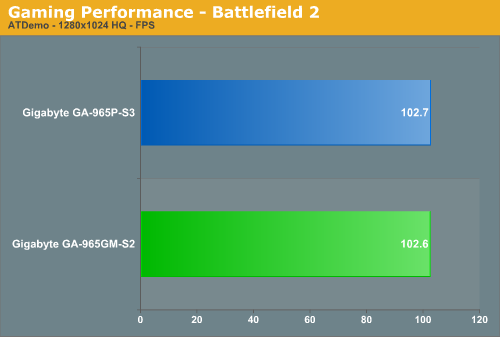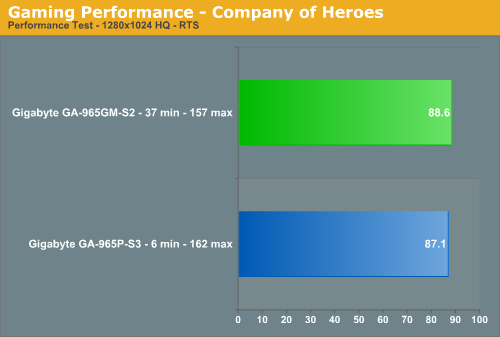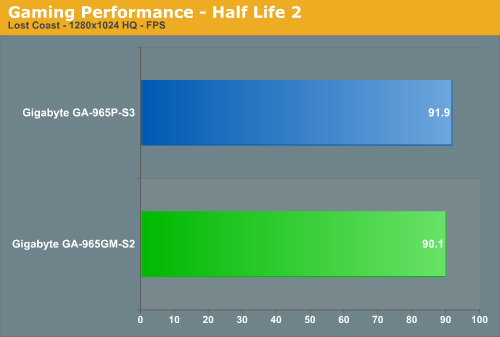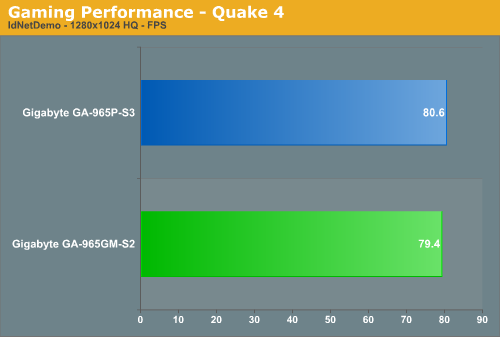Standard Gaming Performance
As usual, gaming performance was tested with a variety of current games. We ran benchmarks with our standard 1280x1024 resolution without antialiasing enabled (and generally without anisotropic filtering, though that varies by game). Given the number of users that run 19" LCDs, 1280x1024 represents one of the most commonly used resolutions. We could certainly increase the amount of eye candy being displayed in most of the games, but as this is a motherboard/chipset benchmark we aren't particularly interested in maxing out the graphics cards in our tests.




Our three FPS games favor the P965 board as we expected since they are memory sensitive at these resolutions and settings. Our CPU crunching RTS game favors the G965 platform as did the previous CPU intensive tests with the most telling benchmark result being the minimum frame rate in Company of Heroes. Our P965 board consistently hit 4 to 6 frames per second minimums in our tests even though its maximum frame rate was always higher. We noticed the same pattern in Age of Empires and Supreme Commander. Otherwise, unless we had tested with a benchmark, the performance difference between the two boards is not noticeable during usage except for a couple of stutters in Company of Heroes.
As usual, gaming performance was tested with a variety of current games. We ran benchmarks with our standard 1280x1024 resolution without antialiasing enabled (and generally without anisotropic filtering, though that varies by game). Given the number of users that run 19" LCDs, 1280x1024 represents one of the most commonly used resolutions. We could certainly increase the amount of eye candy being displayed in most of the games, but as this is a motherboard/chipset benchmark we aren't particularly interested in maxing out the graphics cards in our tests.




Our three FPS games favor the P965 board as we expected since they are memory sensitive at these resolutions and settings. Our CPU crunching RTS game favors the G965 platform as did the previous CPU intensive tests with the most telling benchmark result being the minimum frame rate in Company of Heroes. Our P965 board consistently hit 4 to 6 frames per second minimums in our tests even though its maximum frame rate was always higher. We noticed the same pattern in Age of Empires and Supreme Commander. Otherwise, unless we had tested with a benchmark, the performance difference between the two boards is not noticeable during usage except for a couple of stutters in Company of Heroes.










8 Comments
View All Comments
8steve8 - Tuesday, March 20, 2007 - link
nice to look at the g965, long overdue.but u didnt even touch on integrated graphics.
lots of people out there dont play many 3d games.
you should have compared performance between g965 onboard with g965 discrete with p965 discrete
power/heat numbers would be interesting, then we could see how efficient the integrated x3000 is...
xsilver - Saturday, March 17, 2007 - link
are there ANY G965 boards that DO overclock well?JarredWalton - Saturday, March 17, 2007 - link
Meaning beyond 325MHz bus speeds? No, because the X3000 IGP really limits the chipset's maximum speed. Where on the P965 you're able to overclock the chipset to 500 MHz and above, the IGP can really only take about a 25% overclock - certainly not more than 33% or so. You might be able to hit 350 MHz on some boards, but that's about it as far as I'm aware. Other IGP chipsets on the other hand... we'll have to see Gary's mATX roundup for that information.Treripica - Saturday, March 17, 2007 - link
I'd like to echo MrNeutrino's sentiment. How massive of a mATX roundup can we look forward to in the near future?kobymu - Saturday, March 17, 2007 - link
I just wanted to say thanks for saying that.
While enthusiast discussion is important (I'm PC enthusiast myself), it is always more important to keep a wider, proportional point of view of the industry as a whole, and that sentence has achieved that goal, so when the enthusiasts start discussing higher-end PC components it can take a more practical, sensible approach, and maybe, hopefully, with time we will see a decrease in the "OMG company X is going down!11" department in particular and in radical fanboism in general.
sdsdv10 - Saturday, March 17, 2007 - link
Do you really expect enthusiasts to be either practial or sensible...
That would be kind of an oxy-moron!
MrNeutrino - Saturday, March 17, 2007 - link
Thanks for taking the time to post the mATX performance update, Gary!My performance concerns based on architectural scrutiny of how memory bandwidth is shared between two hungry processors in an IGP chipset vs. its ATX counterpart, were always nagging me as I started looking for a mATX build. Add to that the lack of always reliable reviews - if at all - on the web, and you have the perfect recipe for a burning desire to be sure - and soon - whether almost a thousand some odd dollars of investment in a quality mATX vs. ATX (read: G965 vs. P965) will be worth the money.
At least in my case, the lingering questions were mostly extinguished by your forum reply with quantifiable benchmark data, after the 690G review. What little concern remained (more like intrigue), has been put to rest with these benchmarks and additional comparison data in this article.
Impressive, that there is this little difference between the two chipset / system architecture variants. I suppose then, thanks goes in large part to the hunk of cache on the C2D (compared to CPUs of just a few years back), better predictors / prefetchers, shorter pipelines and a myriad of other uArch improvements.
Anyway, techincal topics aside, all I can say is, HURRAY!!
I'm just happy that this is concrete, published proof that us SFF / mATX fans can have our cake and eat it too!
Now if only we all could also get those April C2D price drops soon enough... :)
Renoir - Saturday, March 17, 2007 - link
Agreed this was a good comparison of the performance between G965 and P965 when BOTH are using a discrete card. As for the question of how sharing memory bandwidth between IGP and CPU compares to using a discrete card, it has only been touched upon briefly by Gary in the forum thread you mentioned. More detailed info on this aspect would be much appreciated in the upcoming roundup (already planned?). Bit-Tech.net did just that with the 690G but they used XP so I'm very interested in the results when using the more bandwidth hungry Aero in Vista.